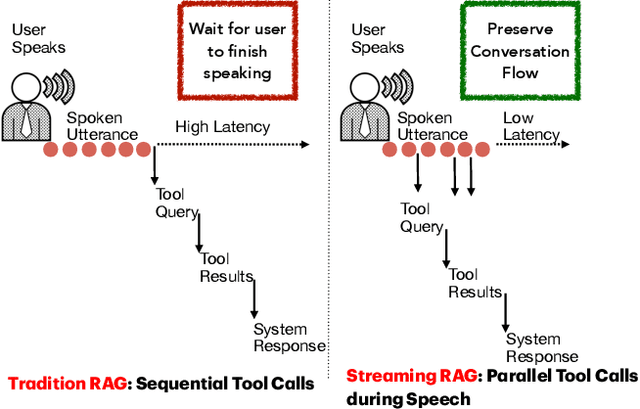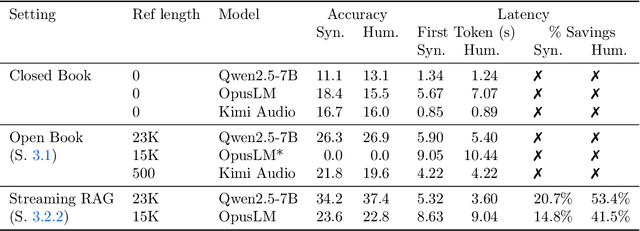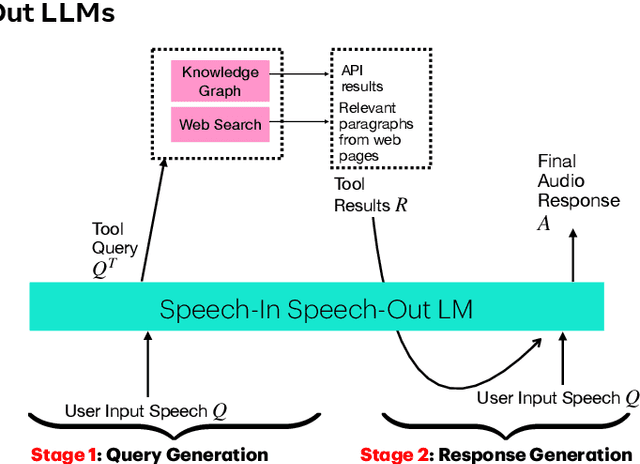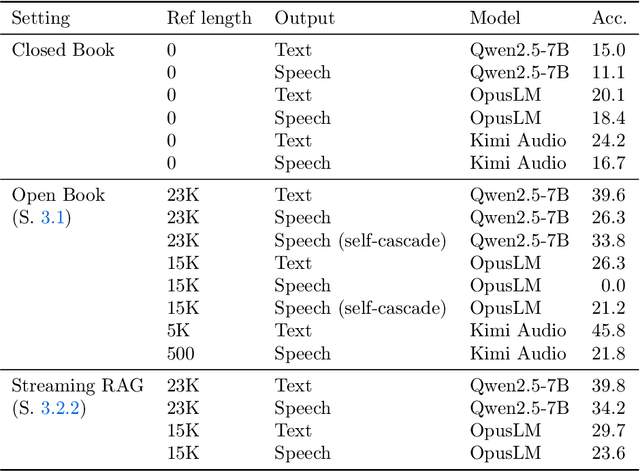Siddhant Arora
Full-Duplex-Bench-v2: A Multi-Turn Evaluation Framework for Duplex Dialogue Systems with an Automated Examiner
Oct 09, 2025Abstract:While full-duplex speech agents enable natural, low-latency interaction by speaking and listening simultaneously, their consistency and task performance in multi-turn settings remain underexplored. We introduce Full-Duplex-Bench-v2 (FDB-v2), a streaming framework that integrates with an automated examiner that enforces staged goals under two pacing setups (Fast vs. Slow). FDB-v2 covers four task families: daily, correction, entity tracking, and safety. We report turn-taking fluency, multi-turn instruction following, and task-specific competence. The framework is extensible, supporting both commercial APIs and open source models. When we test full-duplex systems with FDB-v2, they often get confused when people talk at the same time, struggle to handle corrections smoothly, and sometimes lose track of who or what is being talked about. Through an open-sourced, standardized streaming protocol and a task set, FDB-v2 makes it easy to extend to new task families, allowing the community to tailor and accelerate evaluation of multi-turn full-duplex systems.
Chain-of-Thought Reasoning in Streaming Full-Duplex End-to-End Spoken Dialogue Systems
Oct 02, 2025Abstract:Most end-to-end (E2E) spoken dialogue systems (SDS) rely on voice activity detection (VAD) for turn-taking, but VAD fails to distinguish between pauses and turn completions. Duplex SDS models address this by predicting output continuously, including silence tokens, thus removing the need for explicit VAD. However, they often have complex dual-channel architecture and lag behind cascaded models in semantic reasoning. To overcome these challenges, we propose SCoT: a Streaming Chain-of-Thought (CoT) framework for Duplex SDS, alternating between processing fixed-duration user input and generating responses in a blockwise manner. Using frame-level alignments, we create intermediate targets-aligned user transcripts and system responses for each block. Experiments show that our approach produces more coherent and interpretable responses than existing duplex methods while supporting lower-latency and overlapping interactions compared to turn-by-turn systems.
Stream RAG: Instant and Accurate Spoken Dialogue Systems with Streaming Tool Usage
Oct 02, 2025



Abstract:End-to-end speech-in speech-out dialogue systems are emerging as a powerful alternative to traditional ASR-LLM-TTS pipelines, generating more natural, expressive responses with significantly lower latency. However, these systems remain prone to hallucinations due to limited factual grounding. While text-based dialogue systems address this challenge by integrating tools such as web search and knowledge graph APIs, we introduce the first approach to extend tool use directly into speech-in speech-out systems. A key challenge is that tool integration substantially increases response latency, disrupting conversational flow. To mitigate this, we propose Streaming Retrieval-Augmented Generation (Streaming RAG), a novel framework that reduces user-perceived latency by predicting tool queries in parallel with user speech, even before the user finishes speaking. Specifically, we develop a post-training pipeline that teaches the model when to issue tool calls during ongoing speech and how to generate spoken summaries that fuse audio queries with retrieved text results, thereby improving both accuracy and responsiveness. To evaluate our approach, we construct AudioCRAG, a benchmark created by converting queries from the publicly available CRAG dataset into speech form. Experimental results demonstrate that our streaming RAG approach increases QA accuracy by up to 200% relative (from 11.1% to 34.2% absolute) and further enhances user experience by reducing tool use latency by 20%. Importantly, our streaming RAG approach is modality-agnostic and can be applied equally to typed input, paving the way for more agentic, real-time AI assistants.
Scheduled Interleaved Speech-Text Training for Speech-to-Speech Translation with LLMs
Jun 12, 2025Abstract:Speech-to-speech translation (S2ST) has been advanced with large language models (LLMs), which are fine-tuned on discrete speech units. In such approaches, modality adaptation from text to speech has been an issue. LLMs are trained on text-only data, which presents challenges to adapt them to speech modality with limited speech-to-speech data. To address the training difficulty, we propose scheduled interleaved speech--text training in this study. We use interleaved speech--text units instead of speech units during training, where aligned text tokens are interleaved at the word level. We gradually decrease the ratio of text as training progresses, to facilitate progressive modality adaptation from text to speech. We conduct experimental evaluations by fine-tuning LLaMA3.2-1B for S2ST on the CVSS dataset. We show that the proposed method consistently improves the translation performances, especially for languages with limited training data.
ARECHO: Autoregressive Evaluation via Chain-Based Hypothesis Optimization for Speech Multi-Metric Estimation
May 30, 2025Abstract:Speech signal analysis poses significant challenges, particularly in tasks such as speech quality evaluation and profiling, where the goal is to predict multiple perceptual and objective metrics. For instance, metrics like PESQ (Perceptual Evaluation of Speech Quality), STOI (Short-Time Objective Intelligibility), and MOS (Mean Opinion Score) each capture different aspects of speech quality. However, these metrics often have different scales, assumptions, and dependencies, making joint estimation non-trivial. To address these issues, we introduce ARECHO (Autoregressive Evaluation via Chain-based Hypothesis Optimization), a chain-based, versatile evaluation system for speech assessment grounded in autoregressive dependency modeling. ARECHO is distinguished by three key innovations: (1) a comprehensive speech information tokenization pipeline; (2) a dynamic classifier chain that explicitly captures inter-metric dependencies; and (3) a two-step confidence-oriented decoding algorithm that enhances inference reliability. Experiments demonstrate that ARECHO significantly outperforms the baseline framework across diverse evaluation scenarios, including enhanced speech analysis, speech generation evaluation, and noisy speech evaluation. Furthermore, its dynamic dependency modeling improves interpretability by capturing inter-metric relationships.
BLAB: Brutally Long Audio Bench
May 05, 2025Abstract:Developing large audio language models (LMs) capable of understanding diverse spoken interactions is essential for accommodating the multimodal nature of human communication and can increase the accessibility of language technologies across different user populations. Recent work on audio LMs has primarily evaluated their performance on short audio segments, typically under 30 seconds, with limited exploration of long-form conversational speech segments that more closely reflect natural user interactions with these models. We introduce Brutally Long Audio Bench (BLAB), a challenging long-form audio benchmark that evaluates audio LMs on localization, duration estimation, emotion, and counting tasks using audio segments averaging 51 minutes in length. BLAB consists of 833+ hours of diverse, full-length audio clips, each paired with human-annotated, text-based natural language questions and answers. Our audio data were collected from permissively licensed sources and underwent a human-assisted filtering process to ensure task compliance. We evaluate six open-source and proprietary audio LMs on BLAB and find that all of them, including advanced models such as Gemini 2.0 Pro and GPT-4o, struggle with the tasks in BLAB. Our comprehensive analysis reveals key insights into the trade-offs between task difficulty and audio duration. In general, we find that audio LMs struggle with long-form speech, with performance declining as duration increases. They perform poorly on localization, temporal reasoning, counting, and struggle to understand non-phonemic information, relying more on prompts than audio content. BLAB serves as a challenging evaluation framework to develop audio LMs with robust long-form audio understanding capabilities.
On The Landscape of Spoken Language Models: A Comprehensive Survey
Apr 11, 2025



Abstract:The field of spoken language processing is undergoing a shift from training custom-built, task-specific models toward using and optimizing spoken language models (SLMs) which act as universal speech processing systems. This trend is similar to the progression toward universal language models that has taken place in the field of (text) natural language processing. SLMs include both "pure" language models of speech -- models of the distribution of tokenized speech sequences -- and models that combine speech encoders with text language models, often including both spoken and written input or output. Work in this area is very diverse, with a range of terminology and evaluation settings. This paper aims to contribute an improved understanding of SLMs via a unifying literature survey of recent work in the context of the evolution of the field. Our survey categorizes the work in this area by model architecture, training, and evaluation choices, and describes some key challenges and directions for future work.
ESPnet-SDS: Unified Toolkit and Demo for Spoken Dialogue Systems
Mar 11, 2025



Abstract:Advancements in audio foundation models (FMs) have fueled interest in end-to-end (E2E) spoken dialogue systems, but different web interfaces for each system makes it challenging to compare and contrast them effectively. Motivated by this, we introduce an open-source, user-friendly toolkit designed to build unified web interfaces for various cascaded and E2E spoken dialogue systems. Our demo further provides users with the option to get on-the-fly automated evaluation metrics such as (1) latency, (2) ability to understand user input, (3) coherence, diversity, and relevance of system response, and (4) intelligibility and audio quality of system output. Using the evaluation metrics, we compare various cascaded and E2E spoken dialogue systems with a human-human conversation dataset as a proxy. Our analysis demonstrates that the toolkit allows researchers to effortlessly compare and contrast different technologies, providing valuable insights such as current E2E systems having poorer audio quality and less diverse responses. An example demo produced using our toolkit is publicly available here: https://huggingface.co/spaces/Siddhant/Voice_Assistant_Demo.
Talking Turns: Benchmarking Audio Foundation Models on Turn-Taking Dynamics
Mar 03, 2025



Abstract:The recent wave of audio foundation models (FMs) could provide new capabilities for conversational modeling. However, there have been limited efforts to evaluate these audio FMs comprehensively on their ability to have natural and interactive conversations. To engage in meaningful conversation with the end user, we would want the FMs to additionally perform a fluent succession of turns without too much overlapping speech or long stretches of silence. Inspired by this, we ask whether the recently proposed audio FMs can understand, predict, and perform turn-taking events? To answer this, we propose a novel evaluation protocol that can assess spoken dialog system's turn-taking capabilities using a supervised model as a judge that has been trained to predict turn-taking events in human-human conversations. Using this protocol, we present the first comprehensive user study that evaluates existing spoken dialogue systems on their ability to perform turn-taking events and reveal many interesting insights, such as they sometimes do not understand when to speak up, can interrupt too aggressively and rarely backchannel. We further evaluate multiple open-source and proprietary audio FMs accessible through APIs on carefully curated test benchmarks from Switchboard to measure their ability to understand and predict turn-taking events and identify significant room for improvement. We will open source our evaluation platform to promote the development of advanced conversational AI systems.
ESPnet-SpeechLM: An Open Speech Language Model Toolkit
Feb 21, 2025



Abstract:We present ESPnet-SpeechLM, an open toolkit designed to democratize the development of speech language models (SpeechLMs) and voice-driven agentic applications. The toolkit standardizes speech processing tasks by framing them as universal sequential modeling problems, encompassing a cohesive workflow of data preprocessing, pre-training, inference, and task evaluation. With ESPnet-SpeechLM, users can easily define task templates and configure key settings, enabling seamless and streamlined SpeechLM development. The toolkit ensures flexibility, efficiency, and scalability by offering highly configurable modules for every stage of the workflow. To illustrate its capabilities, we provide multiple use cases demonstrating how competitive SpeechLMs can be constructed with ESPnet-SpeechLM, including a 1.7B-parameter model pre-trained on both text and speech tasks, across diverse benchmarks. The toolkit and its recipes are fully transparent and reproducible at: https://github.com/espnet/espnet/tree/speechlm.
 Add to Chrome
Add to Chrome Add to Firefox
Add to Firefox Add to Edge
Add to Edge